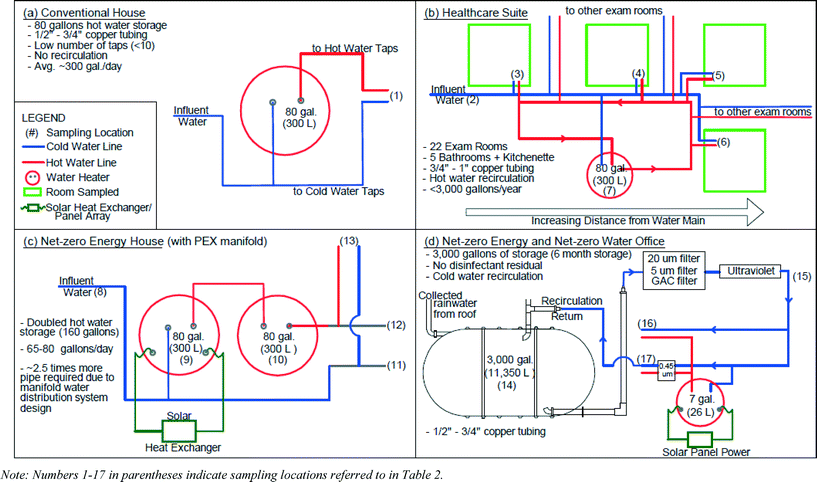There is a new open access paper of possible interest to those working on water systems, green buildings, and/or microbial ecology: Survey of green building water systems reveals elevated water age and water quality concerns – Environmental Science: Water Research & Technology (RSC Publishing) DOI:10.1039/C5EW00221D
By William J. Rhoads, Amy Pruden and Marc A. Edwards in Environmental Science: Water Research & Technology.
Abstract:
Widespread adoption of innovative water conservation strategies has potential unintended consequences for aesthetics and public health. A cross-section of green buildings were surveyed and compared to typical conventional buildings in terms of water retention time (i.e., water age), water chemistry, and levels of opportunistic pathogen genetic markers. Water age was estimated to be 2—6.7 months in an off-grid office, an average of 8 days in a Leadership in Environmental Engineering Design certified healthcare suite, and was increased to 2.7 days from 1 day due to installation of a solar “pre-heat” water tank in a net-zero energy house. Chlorine and chloramine residuals were often completely absent in the green building systems, decaying up to 144 times faster in premise plumbing with high water age when compared to distribution system water. Concentration of 16S rRNA and opportunistic pathogen genus level genetic markers were 1—4 orders of magnitude higher in green versus conventional buildings. This study raises concerns with respect to current green water system practices and the importance of considering potential public health impacts in the design of sustainable water systems.
Here are the authors conclusion:
This work raises concerns with respect to the chemical and microbiological stability of water quality in systems with high water age. The green buildings sampled had exceptionally high water age, and it appears that elevated water age is inherent to achieving sustainability goals of many green building plumbing systems.
The rapid rate of disinfectant loss in buildings with high water age needs to be better understood and addressed. A temporary solution to water quality problems in green buildings connected to drinking water mains involves routine flushing to maintain disinfectant residuals, improve corrosion control, and achieve temperature targets. Long-term solutions include determining if specific water chemistries employed by the utility can retain chemical and microbial stability of water in the distribution and premise plumbing system. Further, research is needed to determine if there are specific premise plumbing devices or plumbing materials that should be avoided.
Conservation strategies employed at each green building created both hot and cold water temperature profiles in plumbing that are conducive to OPPP growth during stagnation. Therefore, strategies for effectively maintaining target temperature profiles in buildings need to be explored. Design of green buildings with water conservation features should minimize overall water age and eliminate unnecessary water storage and should give special attention to avoiding conditions conducive to OPPPs. Determining how severe these anticipated problems are, and how widespread they are likely to become, is a high research priority given the massive investment society is making in green buildings.
I am going to see if I can get some of the authors to provide some comments or context but it certainly seems like this has important implications for future green building design and operation.

